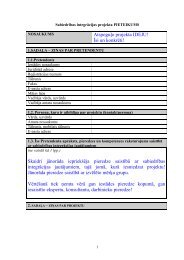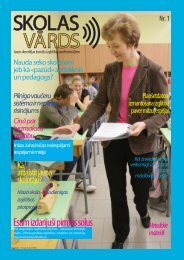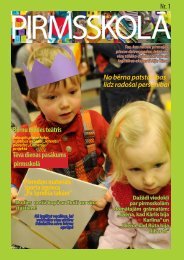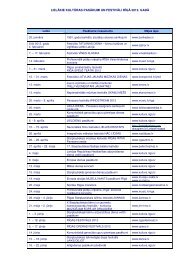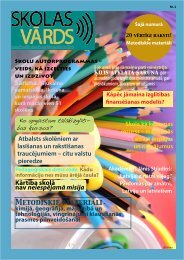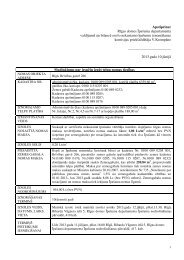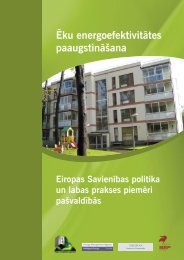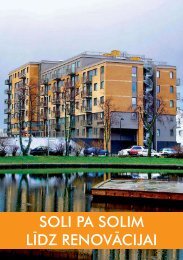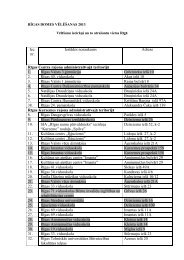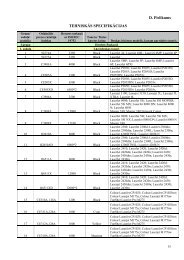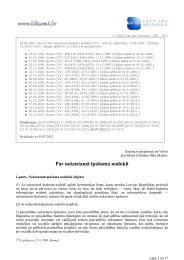Riga - European Capital of Culture 2014 candidate
Riga - European Capital of Culture 2014 candidate
Riga - European Capital of Culture 2014 candidate
- No tags were found...
Create successful ePaper yourself
Turn your PDF publications into a flip-book with our unique Google optimized e-Paper software.
Latvian National Museum <strong>of</strong> ArtĶīpsala Exhibition CentreLatvian National Museum <strong>of</strong> ArtThe mission <strong>of</strong> the Latvian National Museum <strong>of</strong> Art (LNMA) is to use museum resourcesto enrich the widest section <strong>of</strong> society with Baltic and Latvian fine art treasures from thelate 18 th century to today, providing testimonies <strong>of</strong> the historical and artistic expressions<strong>of</strong> the development <strong>of</strong> culture and art in Latvia, the formation <strong>of</strong> the National School <strong>of</strong>Art and its manifestation within the context <strong>of</strong> global cultural history and contemporaryprocesses, and <strong>of</strong> the national identity.The Latvian National Museum <strong>of</strong> Art is the largest depository <strong>of</strong> national art in Latvia. Themuseum building on K. Valdemāra Street is one <strong>of</strong> the most impressive constructions <strong>of</strong>the historicism style in the scope <strong>of</strong> <strong>Riga</strong> boulevards. In turn, the exhibition hall Arsenālsbuilding on Torņa Street is an example <strong>of</strong> the Empire style <strong>of</strong> late Russian classicism.The museum houses more than 52,000 works <strong>of</strong> art. The basic collection <strong>of</strong> the LNMAis composed <strong>of</strong> collections <strong>of</strong> paintings, graphics and sculptures. Permanent exhibitionsthat reflect the development <strong>of</strong> pr<strong>of</strong>essional art in the Baltics and Latvia from the mid-18 thcentury to today can be viewed in the museum, and also reveal vivid episodes <strong>of</strong> Russianart from the 18 th century to the 1 st half <strong>of</strong> the 20 th century.The total size <strong>of</strong> the International Exhibition Centre in Ķīpsala is 17,200 m 2 , it contains a conferencehall that seats 250 people and car parking spaces for 1200 cars. Exhibitions, conferences,congresses, annual markets, concerts and other mass events take place here. Severalworld famous celebrities have performed concerts in Ķīpsala, including Patricia Kaas, RobertPlant, Placebo, Gregorians, Nazareth, Emir Kusturica, Goran Bregovic, R.E.M. and others.Musicals have also been popular – in 2004 and 2005 “The Sound <strong>of</strong> Music”, in 2006 and 2007“West Side Story” and in 2008, Les Miserable, based on the novel by V. Hugo. Ballroom dancingfestivals, Song and Dance Celebration grand performances also take place here.Dome Cathedral and Dome GardenDome Cathedral is the cathedral <strong>of</strong> <strong>Riga</strong> and Latvia’s archbishop and the place <strong>of</strong> worshipfor the Dome parish. The foundation stone <strong>of</strong> Dome Cathedral was laid in a solemnceremony led by Bishop Albert in 1211. The organ built in 1884 by E. F. Walcker & Co. isincluded among the world’s most valuable organs – it has the highest quality <strong>of</strong> technicaland artistic execution and ranks amongst the highest achievements <strong>of</strong> organ constructionart <strong>of</strong> the late Romantic period.Ķīpsala Exhibition CentreLatvian National Museum <strong>of</strong> ArtExhibition Hall ArsenālsThe LNMA regularly organises art exhibitions, participates in international projects, preparesmuseum publications, organises scientific conferences and various art and culturalevents. In parallel to exhibition and display activities, the Latvian National Museum<strong>of</strong> Art carries out intensive educational work. Visitors are <strong>of</strong>fered tours led by museumemployees and special museum pedagogical programmes. A scientific document centreis available for interested parties.Annually, the museum welcomes approximately 130,000 visitors from all over the world.In 2005, the Latvian National Museum <strong>of</strong> Art celebrated the 100 th anniversary <strong>of</strong> its mainbuilding.Latvian National Museum <strong>of</strong> Art Exhibition Hall ArsenālsThe exhibition hall Arsenāls <strong>of</strong> the Latvian National Museum <strong>of</strong> Art, in <strong>Riga</strong> Old Townon Torņa Street 1, is situated in a customs warehouse building <strong>of</strong> the early 19 th century.It was built to the project <strong>of</strong> architect, I. E. de Vitte, in the Empire style <strong>of</strong> late RussianClassicism.The museum collection stored in Arsenāls is composed <strong>of</strong> paintings, graphic art andsculptures that were created in Latvia in the second half <strong>of</strong> the 20 th century to today andthat were produced by artists <strong>of</strong> Latvian origin in the world during the specified period <strong>of</strong>time. Art exhibitions, international projects and other art and cultural events regularly takeplace in the Arsenāls exhibition hall. But on the 2 nd floor, the LNMA Creative Workshopconceptually acquaints society with the untraditional and interactive forms <strong>of</strong> contemporaryart in Latvia and in the world.The organ is an outstanding monument to music history. It is associated with the mostprominent Latvian organists and composers <strong>of</strong> the last 120 years and has affected thedevelopment <strong>of</strong> the art <strong>of</strong> organ music in Latvia more than any other instrument. FerenzLiszt, one <strong>of</strong> the most prominent music personalities <strong>of</strong> the 19 th century, wrote a piece forthe organ especially for the blessing <strong>of</strong> Dome Cathedral organ, Nun danket alle Gott.Both spiritual and cultural events and events <strong>of</strong> national significance take place at DomeCathedral. In the garden, adjoining the cathedral, open-air concerts take place in aunique atmosphere.Dome SquareThe centre <strong>of</strong> Dome Square is the place from where it is possible to see the three gildedcockerels <strong>of</strong> <strong>Riga</strong> Old Town churches. The creation <strong>of</strong> Dome Square commenced inthe late 19 th century, demolishing buildings on the western and north-western sides <strong>of</strong>Dome Cathedral to uncover the access portals to Dome Cathedral. The square hasexperienced the desire by different forces to leave their mark – in its time Dome Squarehas been nominated 15 th May Square, in honour <strong>of</strong> the authoritarian coup d’état, and 17 thJune Square – dedicated to the arrival <strong>of</strong> the Soviet Army into Latvia. Dome Square is atraditional meeting place for city dwellers and guests during city celebrations, the herbmarket at Midsummer, concerts, demonstrations and New Year festivities.St. Peter’s ChurchToday’s city dweller can recognise the church from a distance by its popular gildedcockerel. It is located in the historical centre <strong>of</strong> <strong>Riga</strong> and was included in the UNESCOWorld Cultural Heritage List on 4 th December, 1997. Mentioned for the first time in documentsin 1209, the building <strong>of</strong> St. Peter’s Church is one <strong>of</strong> the oldest and most valuableDome Cathedral and Dome GardenSt. Peter’s Church158 159



